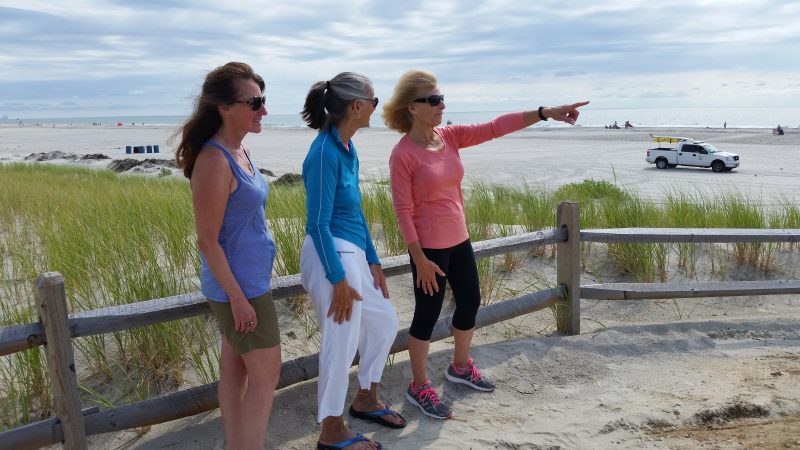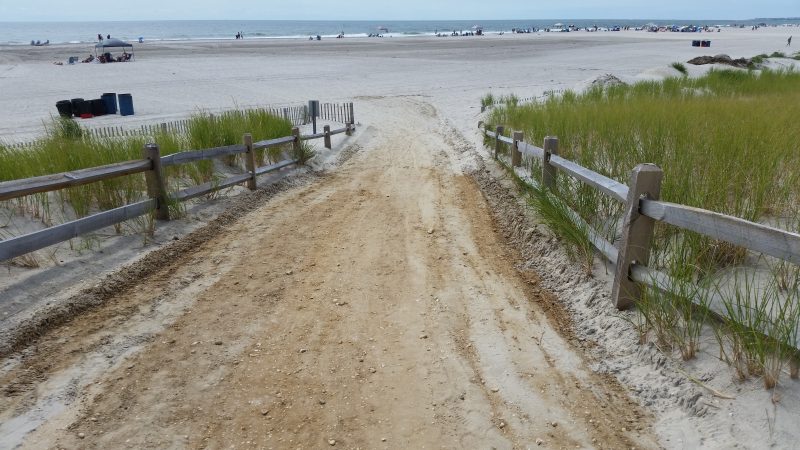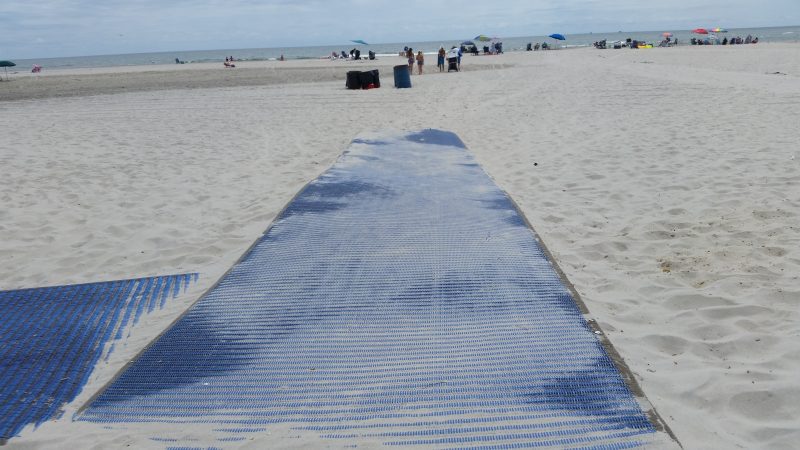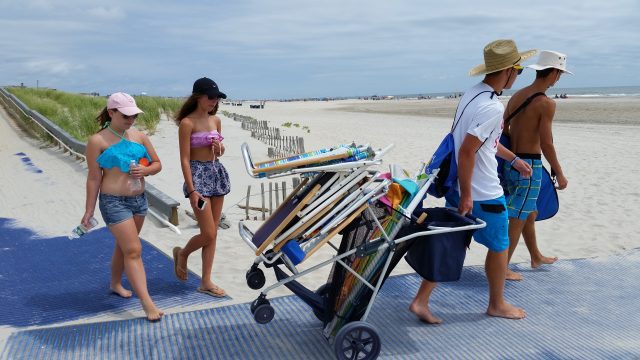By Donald Wittkowski
The walk to the beach at 56th Street in Sea Isle City starts with an easy climb on a gently sloping gravel pathway that crosses over the dunes.
Then, you head downhill a bit while making your way toward the beach. It is at the bottom of the pathway where some beachgoers encounter difficulty, suddenly finding themselves sinking into deep, powdery sand that is hard to navigate.
“It’s an extra workout. You don’t have to go to the gym when you go to the beach,” quipped Julie Schramm, 51, a summer vacationer who is renting a house on 56th Street.
Sea Isle’s beaches were replenished in 2015 and 2016 with nearly 3 million cubic yards of new sand, creating a much wider shoreline spanning the entire 4.5-mile length of the barrier island.
Although the $40 million replenishment project has made Sea Isle the envy of other seashore communities, a debate has started whether the city is doing enough to make the beaches more accessible to senior citizens and people with disabilities.
Schramm and others would like to see the city install handicap-accessible walkways, called “Mobi-Mats,” on the 56th Street beach and elsewhere to make it easier for elderly and disabled people to traverse the soft sand.

Sea Isle has Mobi-Mats on its handicap-accessible beaches at 32nd Street, 40th Street, John F. Kennedy Boulevard, 44th Street, 63rd Street and 85th Street. In addition, it has regraded the beach pathway at 57th Street to provide easier access there, City Business Administrator George Savastano said.
Karen Stollar, who owns a vacation home on 56th Street, appeared at the City Council meeting Tuesday to lobby for more Mobi-Mats on the beaches. Stollar noted that her 93-year-old mother, Virginia Weiner, who lives a block away from her, no longer goes to the 56th Street beach because the sand is simply too deep.
Stollar explained that she formerly would push her mother out onto the beach in a specially designed chair equipped with big wheels. But the chair got bogged down and became too hard to push in the thick sand created by the beach replenishment project.
“We probably have the deepest and widest beaches,” Stollar said. “It is so difficult to walk from one spot to another.”
Weiner, who has lived fulltime in Sea Isle since 1974, began vacationing in the resort with her late husband in the 1950s. Her home at 5500 Pleasure Ave. is only a block from the beach, but she said it is “impossible” for her to get there.
“They can’t even push me through the sand anymore,” Weiner said, referring to the beach chair. “I feel terrible.”
City Council President Mary Tighe, who has championed having better access to the beaches, stressed that the governing body has been working with Mayor Leonard Desiderio’s administration on ways to make it easier for people to walk through the sand.
Tighe, though, pointed out that it would difficult for the city to have Mobi-Mats on every beach in town, from First Street to 94th Street.
“It would be hard to maintain Mobi-Mats on 93 streets,” she said.

Ever since the replenishment project was completed, Sea Isle has concentrated on maintaining the gravel pathways that cross over the dunes to provide easy access to the beaches, city spokeswoman Katherine Custer said.
The city once had more Mobi-Mats on the beaches, but cut back on the number once the replenishment project was finished. The bigger dunes created by the beach project “negated the need” for so many of the mats, Custer said. As a result, the city began focusing on maintaining the hard-packed pathways for better access to the beaches, she noted.
Mobi-Mats, short for mobility mats, are hard, non-slip portable walkways that lie on top of the sand. They are especially convenient for people who are elderly, have disabilities or use wheelchairs.
Colored a distinctive sky blue, the mats are impossible to miss. At Sea Isle’s six handicap-accessible beaches, the Mobi-Mats average 70 feet long, providing an easier transition from the dune pathways to the sandy beaches.
Custer said it costs $2,700 for a 30-foot stretch of Mobi-Mat. With Sea Isle’s mats averaging 70 feet in length, that means it costs around $6,300 to have the walkways at each beach.
“Obviously, they’re not cheap,” Custer said.
Custer said Sea Isle is not planning to add any more Mobi-Mats to the beaches this summer, instead concentrating its efforts on keeping the pathways over the dunes in good shape for easy access.

Stollar, Schramm and Gloria Capron believe there should be more of the mats placed on the beaches, particularly in neighborhoods where there are groups of senior citizens and disabled people. They said the beach they use at 56th Street is one of those areas.
“This is what you come to the shore for – the beaches. You should be able to enjoy them,” said the 71-year-old Stollar, who lives in Marlboro, Monmouth County, and has been vacationing in Sea Isle with her family since she was a child.
Capron, 66, a resident of Kensington, Md., who has a summer home at 5504 Pleasure Ave., said Sea Isle should follow the practice of “universal design” to have the mobility mats spread across town for everyone to use.
“You don’t pick and choose,” she said.
Capron also maintained that Sea Isle should have more of the beach mats to help cultivate its image as a family-friendly vacation community.
“We should be a walkable town, if we are truly a family town offering amenities for everyone,” she said.








